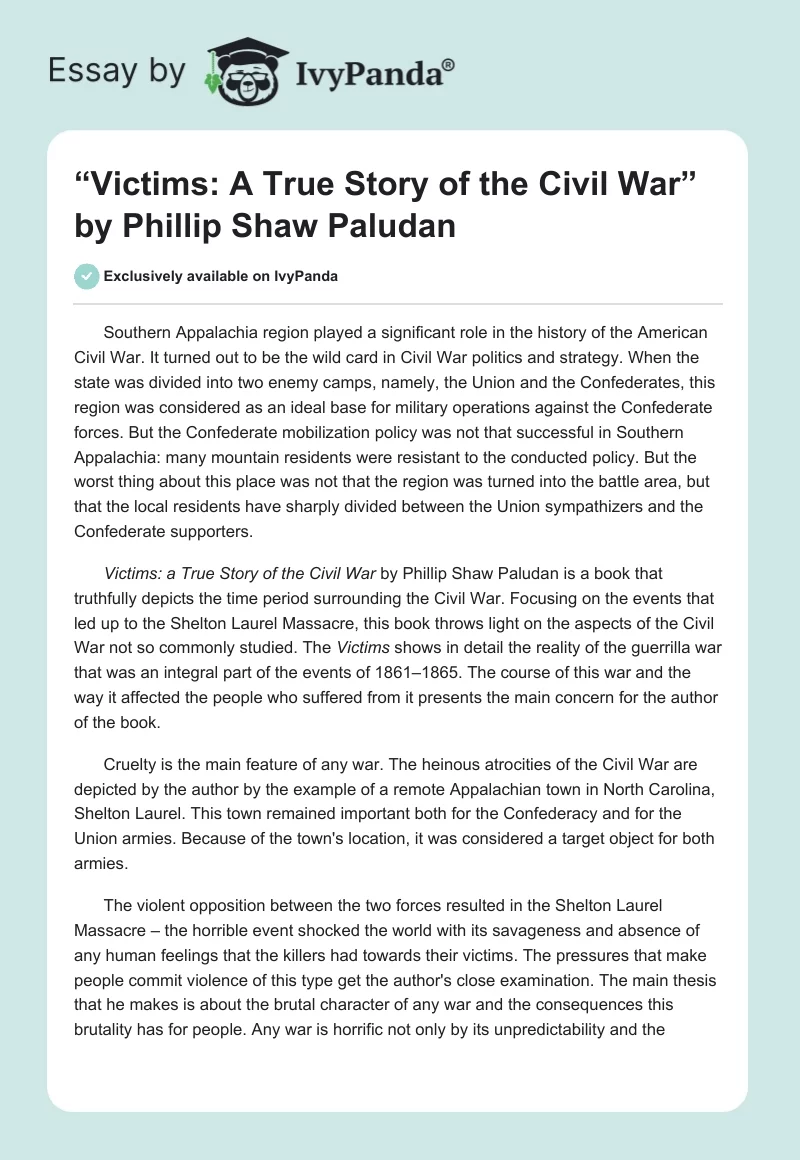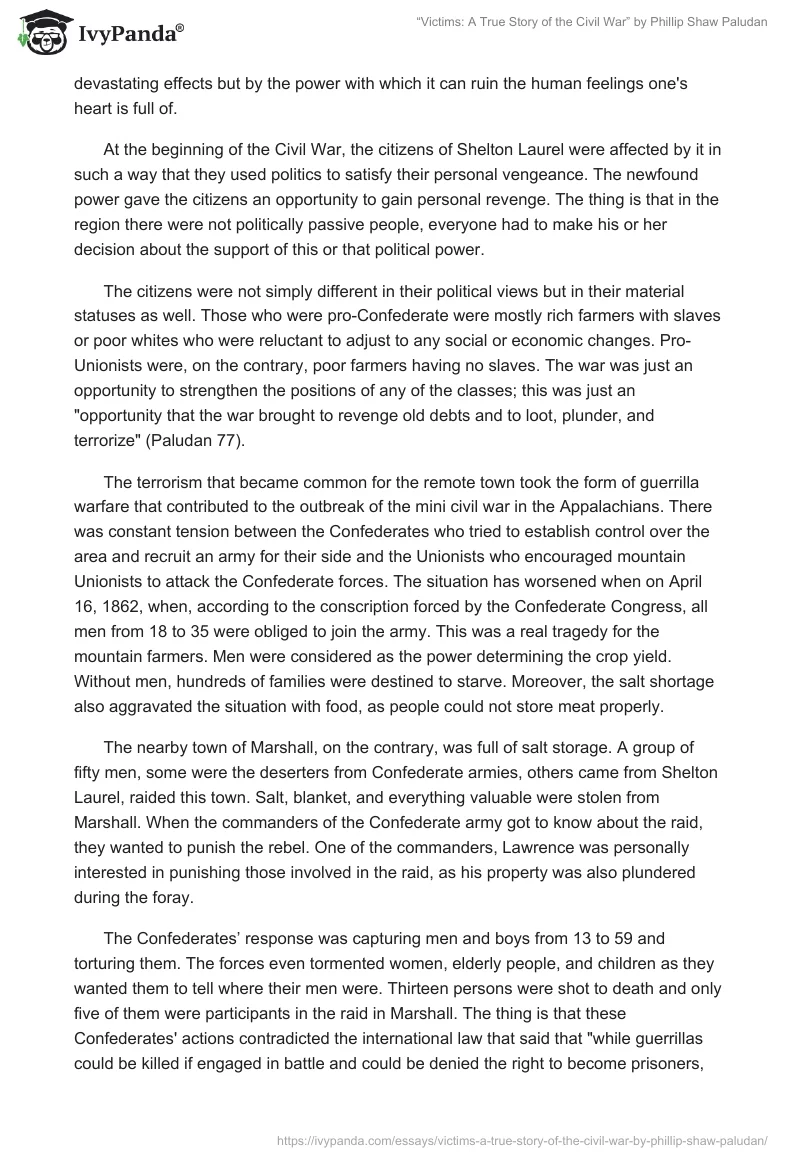Southern Appalachia region played a significant role in the history of the American Civil War. It turned out to be the wild card in Civil War politics and strategy. When the state was divided into two enemy camps, namely, the Union and the Confederates, this region was considered as an ideal base for military operations against the Confederate forces. But the Confederate mobilization policy was not that successful in Southern Appalachia: many mountain residents were resistant to the conducted policy. But the worst thing about this place was not that the region was turned into the battle area, but that the local residents have sharply divided between the Union sympathizers and the Confederate supporters.
Victims: a True Story of the Civil War by Phillip Shaw Paludan is a book that truthfully depicts the time period surrounding the Civil War. Focusing on the events that led up to the Shelton Laurel Massacre, this book throws light on the aspects of the Civil War not so commonly studied. The Victims shows in detail the reality of the guerrilla war that was an integral part of the events of 1861–1865. The course of this war and the way it affected the people who suffered from it presents the main concern for the author of the book.
Cruelty is the main feature of any war. The heinous atrocities of the Civil War are depicted by the author by the example of a remote Appalachian town in North Carolina, Shelton Laurel. This town remained important both for the Confederacy and for the Union armies. Because of the town’s location, it was considered a target object for both armies.
The violent opposition between the two forces resulted in the Shelton Laurel Massacre – the horrible event shocked the world with its savageness and absence of any human feelings that the killers had towards their victims. The pressures that make people commit violence of this type get the author’s close examination. The main thesis that he makes is about the brutal character of any war and the consequences this brutality has for people. Any war is horrific not only by its unpredictability and the devastating effects but by the power with which it can ruin the human feelings one’s heart is full of.
At the beginning of the Civil War, the citizens of Shelton Laurel were affected by it in such a way that they used politics to satisfy their personal vengeance. The newfound power gave the citizens an opportunity to gain personal revenge. The thing is that in the region there were not politically passive people, everyone had to make his or her decision about the support of this or that political power.
The citizens were not simply different in their political views but in their material statuses as well. Those who were pro-Confederate were mostly rich farmers with slaves or poor whites who were reluctant to adjust to any social or economic changes. Pro-Unionists were, on the contrary, poor farmers having no slaves. The war was just an opportunity to strengthen the positions of any of the classes; this was just an “opportunity that the war brought to revenge old debts and to loot, plunder, and terrorize” (Paludan 77).
The terrorism that became common for the remote town took the form of guerrilla warfare that contributed to the outbreak of the mini civil war in the Appalachians. There was constant tension between the Confederates who tried to establish control over the area and recruit an army for their side and the Unionists who encouraged mountain Unionists to attack the Confederate forces. The situation has worsened when on April 16, 1862, when, according to the conscription forced by the Confederate Congress, all men from 18 to 35 were obliged to join the army. This was a real tragedy for the mountain farmers. Men were considered as the power determining the crop yield. Without men, hundreds of families were destined to starve. Moreover, the salt shortage also aggravated the situation with food, as people could not store meat properly.
The nearby town of Marshall, on the contrary, was full of salt storage. A group of fifty men, some were the deserters from Confederate armies, others came from Shelton Laurel, raided this town. Salt, blanket, and everything valuable were stolen from Marshall. When the commanders of the Confederate army got to know about the raid, they wanted to punish the rebel. One of the commanders, Lawrence was personally interested in punishing those involved in the raid, as his property was also plundered during the foray.
The Confederates’ response was capturing men and boys from 13 to 59 and torturing them. The forces even tormented women, elderly people, and children as they wanted them to tell where their men were. Thirteen persons were shot to death and only five of them were participants in the raid in Marshall. The thing is that these Confederates’ actions contradicted the international law that said that “while guerrillas could be killed if engaged in battle and could be denied the right to become prisoners, once they had been captured they could not be executed without legal proceedings to determine their status as guerrillas and their guilt for killing or destroying” (Paludan 87). The killed people were not even returned guilty, no legal procedures were conducted to clarify the case.
Of course, we cannot but admit the fact that the author also explains the reasons for the Confederate troops to act in the way they did: they were frustrated with fighting with a shadowy enemy; the units engaged in the service were demoralized; the command failed at many levels, etc. These reasons do not seem to justify the tortures and the murders caused by the Confederate forces to ordinary people, but the fact of the author studying them is important in terms of looking for the historical truth.
The objective description of the events provided by the author contributes to understanding the Civil War. The very topic chosen by Paludan is a historically neglected one; therefore, it needed someone’s close examination. The theatre of the guerrilla aspect of the Civil War described in detail by Paludan contributes to understanding this issue, as the author has conducted a profound historical study and shared his knowledge with the reader.
The historical findings helped Paludan to embrace larger issues than just the Massacre in North Carolina. The impact of the Civil War on small communities, the causes, and the characteristics of guerrilla warfare with the focus on the human viciousness caused by the war is skillfully depicted in the Victims. This is not the only value of the book under consideration: one can broaden his or her knowledge of the class conflict as well as the modernization process in the Appalachian region.
But being as objective as Paludan was in his work, we should say that, as readers, we need to learn more about the individuals that were killed by the Confederates. It would also be interesting and useful to know about the destiny of those 50 raiders. Moreover, such a detail as the salt stolen from the neighboring town and what happened to it presents considerable interest for us. Though these facts did not influence greatly the course of the Civil War, they are its integral part and the author’s description of them would make his research even more profound.
But still, regarding all this, we do understand that the topic chosen by the author needed this very presentation without omitting some details. And no one will deny the fact that the Victims does not simply provide the reader with the information about the guerrilla warfare as a variant of the Civil War, but encourages him or her to deep into the mysteries of this event in the history of the United States. The reader is expected to learn the material presented in the book, to make his or her own research, and draw conclusions on the problem under consideration.
A vivid description of the events that took place during the Civil War, the accurate details describing the Shelton Laurel Massacre – this is where the author succeeded. Though told in a rather dry language, this book is not only thrilling but important as well. The books of this type approach the understanding of our own history and make it a really valuable thing to deal with.
Works Cited
Paludan, Phillip Shaw. Victims: A True Story Of The Civil War. Univ Tennessee Press, 2004.


